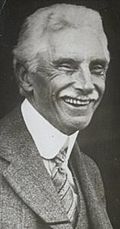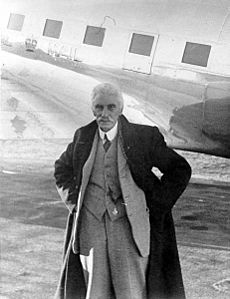Edmund Dwyer-Gray facts for kids
Quick facts for kids
Edmund Dwyer-Gray
|
|
|---|---|
 |
|
| 29th Premier of Tasmania | |
| In office 11 June 1939 – 18 December 1939 |
|
| Governor | Sir Ernest Clark |
| Preceded by | Albert Ogilvie |
| Succeeded by | Robert Cosgrove |
| Treasurer of Tasmania | |
| In office 18 December 1939 – 6 December 1945 |
|
| Premier | Robert Cosgrove |
| Preceded by | Robert Cosgrove |
| Succeeded by | Robert Cosgrove |
| In office 22 June 1934 – 11 June 1939 |
|
| Premier | Albert Ogilvie |
| Preceded by | Walter Lee |
| Succeeded by | Robert Cosgrove |
| Member of the Tasmanian Parliament for Denison |
|
| In office 30 May 1928 – 6 December 1945 |
|
| Personal details | |
| Born |
Edmund John Chisholm Dwyer Gray
2 April 1870 Dublin, Ireland |
| Died | 6 December 1945 (aged 75) Hobart, Tasmania, Australia |
| Political party | Labor |
| Spouse | Clara Agatha Rose |
| Relations | Sir John Gray (grandfather) Caroline Chisholm (grandmother) Edmund Dwyer Gray (father) |
| Occupation | Newspaper editor |
Edmund John Chisholm Dwyer-Gray (born April 2, 1870, died December 6, 1945) was an important Irish-Australian politician. He served as the 29th Premier of Tasmania for a short time in 1939. He was a member of the Australian Labor Party, often called the ALP.
Contents
Early Life and Family Connections
Edmund John Chisholm Dwyer Gray was born in Dublin, Ireland, on April 2, 1870. His father, also named Edmund Dwyer Gray, was a Member of Parliament (MP) in the British House of Commons. His mother was Caroline Agnes Gray.
Edmund had famous grandparents. His grandmother, Caroline Chisholm, was an English humanitarian. She was known for helping female immigrants in Australia. His grandfather, Sir John Gray, was an Irish MP. He was also connected to the Irish nationalist leader Daniel O'Connell.
Edmund went to school at a Benedictine monastery in Scotland. He also studied at Clongowes Wood College, a Jesuit school in Ireland.
Becoming a Newspaper Editor
Edmund first visited Australia in 1887. He hoped the warmer climate would help his rheumatism, a condition that causes joint pain. He soon returned to Ireland.
Back in Ireland, he joined the Freeman's Journal newspaper. This newspaper supported Irish independence. His father and grandfather had owned it. While visiting Australia, he met and married his wife, Clara.
The Freeman's Journal became involved in a political scandal. This led Edmund to change the newspaper's focus. This caused some disagreements. Because of this, he decided to move to Australia for good.
Life in Australia and Journalism
After moving to Australia, Edmund traveled around. He visited New Zealand and Fiji. He even tried some mining projects. Then, he spent ten years as a farmer in New Norfolk, Tasmania.
By 1912, he was in Hobart. He was editing the Daily Post, a newspaper for the Australian Labor Party. When another union took over the paper, he moved to Sydney. He worked there briefly for Jack Lang.
Later, he returned to Hobart. In 1925, he started a new newspaper called the People's Voice. It was for the ALP and the ACTU. He continued to edit this paper until he died in 1945.
Entering Tasmanian Politics
In 1915, Gray tried to get elected to the Tasmanian Legislative Council, but he didn't win. For the 1928 state election, he changed his name to Dwyer-Gray. He added a hyphen to his last name. This was a clever trick to get his name at the top of the voting list. This helped him get more votes.
It worked! Dwyer-Gray was elected to the House of Assembly. He represented the area of Denison for the Labor Party. In 1932, he became the party's deputy leader.
When Albert Ogilvie won the 1934 state election, Dwyer-Gray became the Treasurer and Deputy Premier. The Treasurer is like the finance minister for the state.
As Treasurer and editor of Voice, Dwyer-Gray supported a new economic idea called social credit. He believed it could make Tasmania a "worker's paradise." He thought New Zealand was a good example of how it could work.
Premier of Tasmania
Albert Ogilvie, the Premier, sadly died in office on June 10, 1939. On July 6, Dwyer-Gray was chosen as the new leader of the ALP. This made him the Premier of Tasmania.
However, he was Premier for only six months. He had an agreement with another politician, Robert Cosgrove. Dwyer-Gray agreed to step aside for Cosgrove to become Premier in December 1939.
Later Life and Achievements
In 1940, Dwyer-Gray wrote an article in Voice praising a healer named Mahomet Allum. He called him "a better Christian than most Christians."
Dwyer-Gray passed away in Hobart on December 6, 1945. His wife survived him, passing away in 1947.
Even though some of his ideas were quite new for his time, Dwyer-Gray did a lot of good for Tasmania. He pushed hard for the Prime Minister, Joseph Lyons, to help small states like Tasmania with money problems. This was especially important after the Great Depression, a time when many people lost their jobs and money.
Dwyer-Gray helped Tasmania get special financial support. This "brought home the bacon," meaning he secured important funds. These funds allowed the next Premier, Robert Cosgrove, to improve public health, government services, and develop hydroelectric power in the state.
Images for kids



